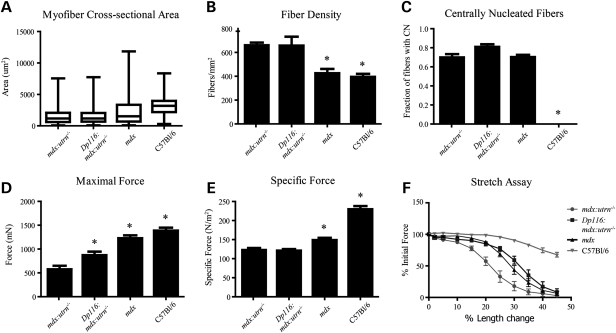Figure 4.
Evaluation of myofibers and contractile properties of TA in Dp116:mdx:utrn−/− mice. (A) Myofiber cross-sectional area (n = 500 fibers per animal) and (B) density (n = four 0.13 mm2 fields per muscle) are unaffected by Dp116 expression and remain reduced compared with age-matched C57Bl/6 and mdx animals. (C) The percentage of myofibers with centrally located nuclei (n = four 0.13 mm2 fields per muscle) was not significantly different from that shown in mdx or mdx:utrn−/− animals. (D) Maximal force is increased in Dp116:mdx:utrn−/− mice when compared with mdx:utrn−/− mice, but (E) specific force remains low. (F) Contractile performance after lengthening contractions with progressively increasing strain is improved in Dp116:mdx:utrn−/− mice, but is still reduced below that shown in wild-type animals; n = 5–7 animals per group. Bars in (A–C) and (E and F) indicate ±SEM; Boxes in (D) represent fiber areas between the 25th and 75th percentiles; midline indicates median fiber area; bars extend to minimum and maximum area measurements. Asterisks indicate significant difference from mdx:urtn−/− (P < 0.05).

